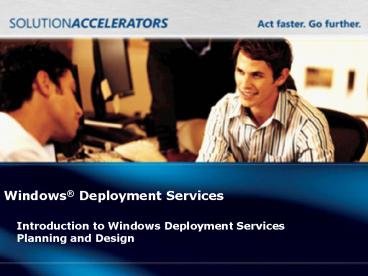Windows Deployment Services - PowerPoint PPT Presentation
1 / 15
Title:
Windows Deployment Services
Description:
Infrastructure Planning and Design (IPD) provides planning and design guidance ... Relates decisions and options for the business. ... – PowerPoint PPT presentation
Number of Views:2751
Avg rating:3.0/5.0
Title: Windows Deployment Services
1
Windows Deployment Services
- Introduction to Windows Deployment Services
Planning and Design
2
What Is IPD?
- Infrastructure Planning and Design (IPD) provides
planning and design guidance that aims to clarify
and streamline the planning and design process
for Microsoft infrastructure technologies. - IPD
- Defines decision flow.
- Describes decisions to be made.
- Relates decisions and options for the business.
- Frames additional questions for business
understanding.
3
Windows Deployment Services
- Getting Started
4
The Role of Windows Deployment Services in
Infrastructure Optimization
Dynamic
Rationalized
Basic
Standardized
Windows Deployment Services 2008
5
Purpose and Overview
- Purpose
- To provide design guidance for Windows Deployment
Services - Agenda
- Windows Deployment Services overview
- Windows Deployment Services architecture design
process
6
Windows Deployment Services Overview
- Rapid deployment of Windows operating systems
- Easy to administer
- Image-based deployment solution
7
Windows Deployment ServicesDesign Flow
8
Determine the Number of Windows Deployment
Services Instances Required
- Identify locations requiring access to a Windows
Deployment Services instance - The Windows Deployment Services server should be
located close to the client computers to which it
will deploy the instances. - Locations should have sufficient bandwidth and a
low-latency connection between the Windows
Deployment Services server and client computers. - Determine the need for multiple Windows
Deployment Services installations in a single
location - Isolated networks
- Low bandwidth
9
Is There an Existing Windows Deployment Services
or RIS Infrastructure?
- New Windows Deployment Services 2008
installation - Ideal for a new installation
- Can also be used to perform a parallel upgrade
(Deploy Windows Deployment Services 2008,
decommission the old infrastructure.) - Upgrade an existing Windows Deployment Services
2003 or RIS infrastructure - Set Windows Deployment Services 2003 to Native
mode. - Convert RIS-based images to WindowsImaging
Format (WIM) images. - First upgrade RIS to Windows DeploymentServices
Native mode.
10
Select Between Full Windows Deployment Services
or the Transport Server Role
- Full Windows Deployment Services
- Pre-Boot Execution Environment (PXE) boot
services - Microsoft Management Console (MMC) tools
- The ability for administrators to select which
image to install from a presented list - Both unicast and multicast deployments
- Transport server only
- Used when the Active Directory directory
service, Domain Name System (DNS), and Dynamic
Host Configuration Protocol (DHCP) are not
available. - No PXE boot available.
11
Determine the Server Resource Requirements
- Identify deployment requirements for each Windows
Deployment Services instance - Total number of computers
- Image deployment speed
- Size and number of images
- Determine whether virtualization will be used
- Hyper-V will allow a 64-bit deployment
environment. - Determine the WIM storage location
- Low-latency access is required.
- Scale the servers
- Determine the baseline.
- Scale the servers CPU, memory, network,and
disk. - Determine the number of servers for the location.
12
Determine the File Share Fault Tolerance and
Consistency Mechanism
- Determine image storage system fault tolerance
- Distributed File System (DFS)
- Server clustering
- WIM-based image consistency
- Manual copy/manage image locally
- DFS with replication
- Non-Microsoft replication
13
Determine the Client Windows Deployment Services
Discovery Method
- Using network boot referralsuses DHCP boot
referrals - 66 Boot server host name (Set to the Windows
Deployment Services server name.) - 67 Boot file name (Set to the boot file name
that the client computers attempt to download and
execute.) - Using IP helpers
- Configure routers and switches to forward UPD
port 67 broadcasts from client computers toDHCP/
Windows Deployment Servicesservers in other
subnets.
14
Conclusion
- Carefully consider infrastructure requirements
for Windows Deployment Services. - Planning is key.
- This guide offers major architectural guidance.
Refer to product documentation for additional
details.
15
Questions?































